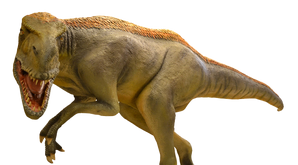
Eotyrannus (meaning "dawn tyrant") is a genus of tyrannosauroid theropod dinosaur hailing from the Early Cretaceous Wessex Formation beds, included in Wealden Group, located in the southwest coast of the Isle of Wight, United Kingdom. The remains (MIWG1997.550), consisting of assorted skull, axial skeleton and appendicular skeleton elements, from a juvenile or subadult, found in a plant debris clay bed, were described by Hutt et al. in early 2001.[1] The etymology of the generic name refers to the animals classification as an early tyrannosaur or "tyrant lizard", while the specific name honors the discoverer of the fossil.
Description[]

Eotyrannus has the following tyrannosauroid characters: serrated premaxillary teeth with a D cross section, proportionally elongate tibiae and metatarsals. Primitive characters for Tyrannosauroidea are the elongate neck vertebrae and the long, well-developed arms forelimbs along with the undecorated dorsal surface of the skull, unlike the more advanced tyrannosaurids. However this animal, proportionally, has one of the longest hands among non-avialan theropods known to date. This theropod would be a probable predator of such herbivorous dinosaurs as Hypsilophodon. The holotype of Eotyrannus are estimated to have measured about 3.9 m (13 ft) long. However, as it is believed to have been juvenile, an adult specimen might have been somewhat larger.
Phylogeny[]
The discovery of Eotyrannus corroborates the notion that early tyrannosauroids were gracile with long forelimbs and three-fingered grasping hands, although the somewhat large size of the animal either means that early evolution for this clade was carried out at a large size or Eotyrannus developed large size independently.[2] The find of this animal in Europe puts in question to the purported Asian origin for these animals along with North American Stokesosaurus and European Aviatyrannis arguing for a more complex biogeography for tyrannosauroids.[3]
Below is a cladogram by Loewen et al. in 2013 that includes most tyrannosauroid genera.[3]
Template:Clade/Tyrannosauroidea1
A recent analysis has found Eotyrannus to be a megaraptoran closely related to taxon like Megaraptor (Profiri et al., 2014)[4]
Template:Clade/Megaraptora1
See also[]
- Timeline of tyrannosaur research
References[]
- ↑ Hutt, S., Naish, D., Martill, D.M., Barker, M.J., and Newbery, P. (2001). "A preliminary account of a new tyrannosauroid theropod from the Wessex Formation (Cretaceous) of southern England." Cretaceous Research, 22: 227–242.
- ↑ Holtz, T. R. Jr. (1994). "The phylogenetic position of the Tyrannosauridae: implications for theropod systematics." Journal of Paleontology, 68: 1100–1117.
- ↑ 3.0 3.1 Template:Cite journal
- ↑ Template:Cite journal